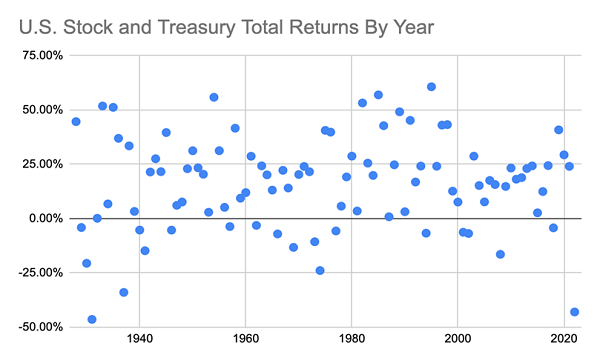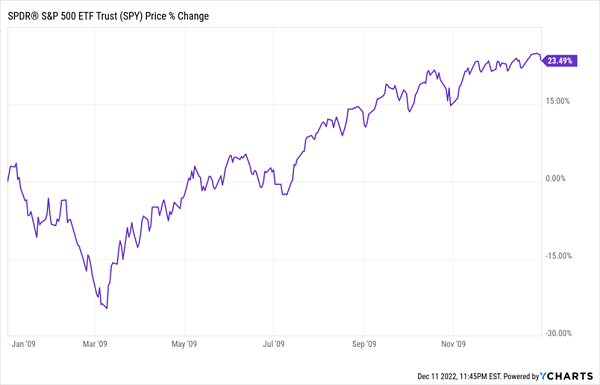Good news: this dreadful year has created the conditions for a nice market bounce in 2023. And we CEF investors are in a nice position to capitalize with 9.8% dividends and potential 38%+ total returns next year.
I’ll name three closed-end funds (CEFs) with discounts big enough to deliver that potential 38%+ gain below. All they need to do is return to their “normal” valuations, and chip in just a touch of upside from their portfolios, too.
For starters, though, I’ll tell you that 9.8% is the average yield on the portfolio of my CEF Insider service. And that’s just the average. We’ve got plenty of funds yielding well into double digits, with our highest payer yielding 13.5% today.
And thanks to the fact that none of our picks have cut payouts in 2022, we’ve been able to rely on those dividends to see us through this difficult year. Times like this are exactly why we buy these high-income funds.
But what about next year? The good news, as mentioned, is that 2022’s misery could set us up for much better performance in 2023. Here’s why.
Weak Market, Stock/Bond Convergence Set Stage for Gains
To get a sense of just how unusual it is for stocks and bonds to fall at the same time, as they have this year, consider this chart:

Source: CEF Insider
Each blue dot above represents the combined returns of US stocks and Treasuries in a given year. While most are positive, 2020’s negative 42.98% is the second-worst year on record, behind 1931, when stocks plummeted 43.8% and Treasuries fell 2.6%. Note also how we’re well behind 2008’s 16.5% loss, as well.
So why is this good news for 2023?
One reason is simple reversion to the mean: when stocks are in a bear market for longer than nine months, they tend to quickly snap back to where they were before the bear market, just like they did in 2009, after the S&P 500 fell 38% in 2008.
2008 Crash Triggered a Fast Bounce Back

Back then, the S&P 500 had been falling for eight months (we’re now in month 12 of the current decline), and the global economy was in the deepest recession since the Great Depression. It was in that time of despair that stocks started their recovery. And contrarians who bought when the market was at its lowest saw big, fast gains.
The Federal Reserve’s 2018 rate hikes gave us a similar opportunity, as did the pandemic.
Still, I understand if you’re hesitant to buy now. But consider also that we’re now up about 10% from the bottom hit in mid-October, with rising trading volumes indicating higher demand for stocks (and by extension stock-focused CEFs).
Moreover, GDP growth has been accelerating, with the Fed now estimating a 3.2% rise in the fourth quarter, after the third quarter’s 2.9% gain. That raises the likelihood of a recession being delayed for longer than most people expect. And if a recession does occur, this kind of growth makes it more likely that it will be short and shallow.
And finally, S&P 500 firms are expected to deliver 5.5% earnings growth predicted in 2023, which is still strong after the forecast 6.1% earnings growth for 2022.
The best news is that this market’s fear has created bargains within bargains in the CEF space, as our funds themselves sport healthy discounts to net asset value (NAV) on their already-oversold portfolios!
Just consider the 22.2%-discounted BlackRock Innovation and Growth Trust (BIGZ), which yields 11.8%; the Neuberger Berman Next Generation Connectivity Fund (NBXG), with its 20.9% discount and 12.6% yield; and the BlackRock Health Sciences Trust II (BMEZ), which has a 17% discount and an 11% dividend.
As for these funds’ holdings, you’re getting the best of high-quality American firms seeing strong revenue growth in a host of sectors. They include strong tech firms like Palo Alto Networks (PANW), NVIDIA (NVDA) and ServiceNow (NOW), as well as rebounding service-sector companies like Planet Fitness (PLNT).
All of these funds had smaller discounts at the start of the year; some traded at a premium to their portfolio’s real market value just weeks before 2022 began. Buying them now that they’re heavily discounted gives you better odds of strong returns.

As the table above shows, if these funds just go back to their earlier near-par valuations and their portfolios rise another 10%, we could see around 38% average returns. But even if their portfolios trade sideways, just our discount-driven gains would produce a 25% return.
5 Bargain-Priced Monthly Dividend CEFs With Rock-Solid 8.9% Payouts
We love CEFs that pay dividends every month, for two reasons:
- They’re very investor-friendly, with payouts that nicely line up with our bills, and …
- A monthly payout shows a management team with swagger. They simply wouldn’t offer a monthly payout unless they were confident they could keep that dividend rolling out to us shareholders.
These are just two reasons why we love to see monthly payouts from the CEFs we buy. And I’ve recently produced an updated report giving you the 5 very best monthly paying CEFs to buy now.
Taken together, these 5 stout monthly payers yield a gaudy 8.9%. And thanks to their deep discounts, I’m calling for double-digit upside from each of them in 2023!
